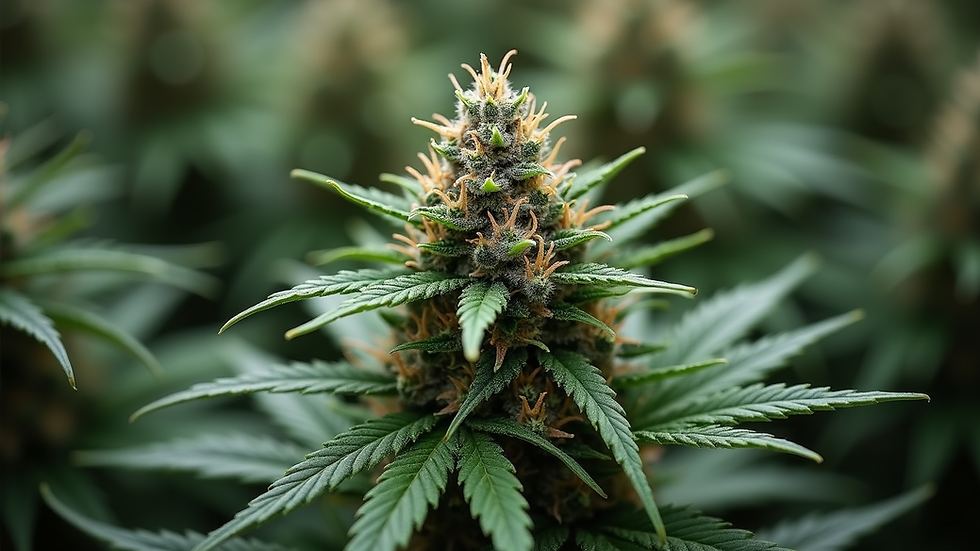Indica vs. Sativa: Key Differences Explained
- Jacob Correia
- Sep 19
- 4 min read
When exploring cannabis, one of the first distinctions you’ll encounter is between Indica and Sativa strains. These two categories have unique characteristics that influence their effects, growth patterns, and uses. Understanding the differences can help you make informed choices whether you’re a recreational user, a medical patient, or simply curious about cannabis.
Cannabis plants are complex, and the terms Indica and Sativa are often used to describe their physical traits and the effects they produce. However, the science behind these differences is evolving, and many hybrids blur the lines. This article will break down the key points to help you grasp the essentials of the Indica vs Sativa comparison.
Indica vs Sativa Comparison: Physical and Growth Differences
The most noticeable differences between Indica and Sativa plants are their physical appearance and growth habits.
Indica plants tend to be shorter and bushier. They have wide, broad leaves and dense buds. Indicas usually grow faster and have a shorter flowering time, making them popular for indoor cultivation.
Sativa plants are taller and leaner with narrow leaves. They can grow quite tall, sometimes reaching over 12 feet outdoors. Sativas have a longer flowering period and are often preferred for outdoor growing.
These physical traits are important for growers to consider based on their space and climate. For example, if you have limited indoor space, Indica strains might be more suitable. Conversely, if you have a large outdoor area with a long growing season, Sativa strains could thrive better.

Close-up view of a tall Sativa cannabis plant with narrow leaves
Effects and Uses: How Indica and Sativa Differ
One of the main reasons people differentiate between Indica and Sativa is the effects they produce.
Indica strains are often associated with relaxing, sedative effects. They are known to help with pain relief, insomnia, and anxiety. Many users describe Indica as a "body high" that promotes calmness and sleepiness.
Sativa strains tend to be more uplifting and energizing. They are linked to increased creativity, focus, and sociability. Sativas are often chosen for daytime use because they can enhance mood and mental clarity.
It’s important to note that these effects can vary depending on the specific strain and individual response. The chemical compounds in cannabis, such as THC and CBD, along with terpenes, play a significant role in shaping the experience.
For those seeking medical benefits, Indica strains might be better for nighttime symptom relief, while Sativas could be more effective for daytime conditions like depression or fatigue.

Eye-level view of cannabis buds with dense Indica characteristics
Is Sativa an Upper or Downer?
A common question is whether Sativa acts as an upper or a downer. The answer is that Sativa is generally considered an upper.
Sativa strains typically stimulate the mind and body, producing a euphoric and energetic feeling. This makes them popular for social activities, creative projects, and physical activities. The uplifting effects can help combat feelings of lethargy or depression.
However, some people may experience anxiety or restlessness with high-THC Sativa strains, so it’s important to start with a low dose if you’re new to cannabis or sensitive to stimulants.
In contrast, Indica strains are more likely to have downer effects, promoting relaxation and sedation.

High angle view of a cannabis leaf with narrow Sativa leaflets
Understanding the Chemical Makeup: THC, CBD, and Terpenes
The effects of Indica and Sativa are influenced by their chemical profiles, especially the levels of THC (tetrahydrocannabinol) and CBD (cannabidiol), as well as terpenes.
THC is the psychoactive compound responsible for the "high" feeling. Both Indica and Sativa strains can have high THC levels, but the experience may differ.
CBD is non-psychoactive and often used for its therapeutic properties. Some Indica strains have higher CBD content, which can balance the effects of THC.
Terpenes are aromatic compounds that contribute to the smell and flavor of cannabis. They also influence the effects. For example, myrcene, common in Indicas, has sedative properties, while limonene, found in many Sativas, can elevate mood.
When choosing a strain, consider the chemical profile as much as the Indica or Sativa label. This will give you a better idea of the potential effects and benefits.
Practical Tips for Choosing Between Indica and Sativa
If you’re deciding between Indica and Sativa, here are some practical tips:
Identify your goal: Are you looking for relaxation, pain relief, or sleep? Indica might be best. Need energy, creativity, or mood enhancement? Sativa could be the answer.
Consider the time of day: Use Sativa during the day to stay alert and Indica at night to unwind.
Start low and go slow: Especially if you’re new, begin with a small dose to see how your body reacts.
Look at the strain’s chemical profile: Check THC, CBD, and terpene content for a more accurate prediction of effects.
Try hybrids: Many strains combine Indica and Sativa traits, offering balanced effects.
For more detailed information on indica sativa differences, you can visit trusted cannabis resources that provide strain reviews and user experiences.
Beyond Indica and Sativa: The Future of Cannabis Classification
The traditional Indica vs Sativa classification is becoming less clear as breeders create hybrids with mixed genetics. Modern cannabis strains often contain a blend of Indica and Sativa traits, making it harder to predict effects based solely on these categories.
Scientists are now focusing more on the chemical composition and genetics of cannabis rather than just physical appearance. This approach helps users find strains tailored to their specific needs.
Understanding this shift can help you stay informed and make better choices as the cannabis industry evolves.
By learning the key differences between Indica and Sativa, you can better navigate the world of cannabis. Whether you want relaxation, energy, or medical relief, knowing these basics will guide you to the right strain for your needs. Remember to consider the chemical profile and your personal preferences for the best experience.




Comments